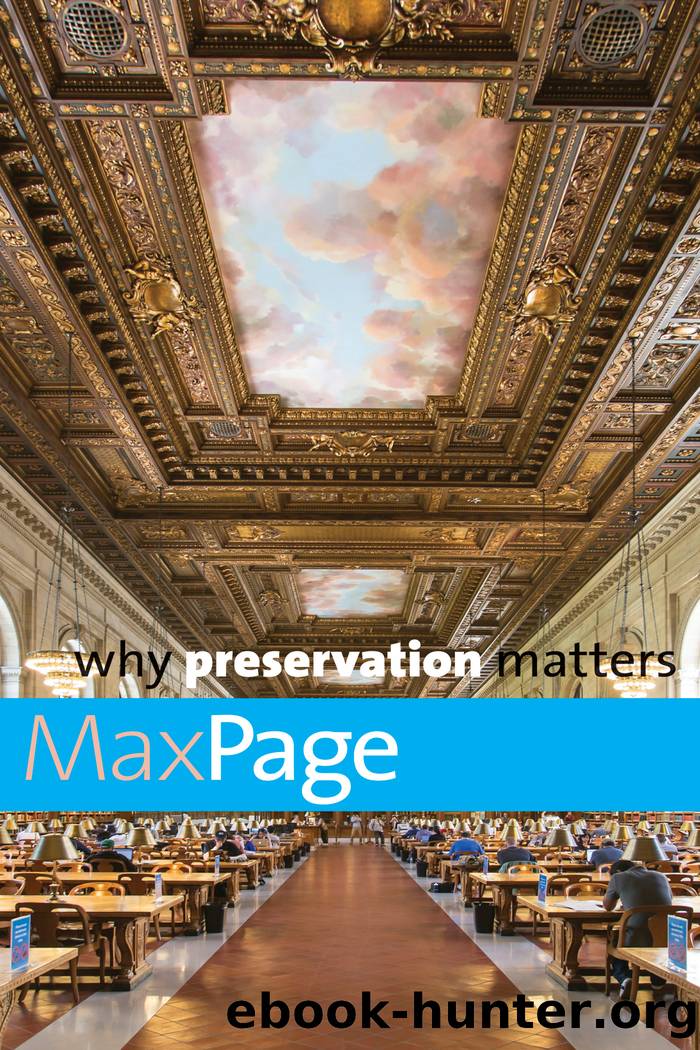Why Preservation Matters by Max Page

Author:Max Page
Language: eng
Format: epub
Publisher: Yale University Press
Published: 2016-07-14T16:00:00+00:00
Factory and Canal in Holyoke, Massachusetts, 2013 The abandoned factories of Holyoke, once the papermaking capital of the country, are slowly being renovated. The water flowing through turbines underneath the buildings—visible on the right side of the photograph—produces clean energy that provides a majority of the city’s electrical power.
In an era of climate change, when all around the world we are concerned about conserving energy and stopping the bellowing of pollutants into the air, when we are finally starting to rethink our reliance on fossil fuels and the automobile, we can find some answers in places like Holyoke.
The young, locally born mayor, Alex Morse, has brought attention to the city and pointed it in the right direction. Amtrak trains began stopping in Holyoke for the first time in decades. The canals are being spruced up to encourage development. In collaboration with the University of Massachusetts, the Massachusetts Institute of Technology, and CISCO Systems, the city built the Massachusetts Green High Performance Computing Center (MGHPCC)—essentially a computer farm, but the greenest computer farm in New England. Why did the consortium choose Holyoke? Because land was cheap there, but so was energy. Although the university and its partners missed a major restoration opportunity when they constructed a new building instead of renovating a historic one, they did build it in the downtown area, along the first level of canals, where it contributes to the return of activity to the city. Slowly private development is returning, although it mainly takes the form of small firms and artist studios that might foreshadow gentrification.
Holyoke is still in dire condition. Impoverished, with a pockmarked streetscape, as many buildings being torn down as going up, and little in the way of new jobs—a grand total of nine full-time people are needed for the operation of the MGHPCC—the city is in need of a more fundamental shift in attitude and policies if it is to recover. And this is where preservationists come in.
Preservationists can help rebuild the city by making the case for preserving its industrial heritage, less on aesthetic grounds than in the interest of climate change: by saving Holyoke’s sturdy nineteenth-century paper-industry buildings and taking advantage of the cheap clean energy produced by the 150-year-old canal system, the city will be building toward a more economically vibrant and environmentally sustainable future. Preservationists can tout Holyoke’s history of sustainability, work for state and federal incentives to rebuild the buildings and infrastructure, and reorient its tax and development policies. People could begin to view Holyoke not through brown-tinted glasses but green ones. If preservationists make the case that the old housing and industrial stock could easily and affordably be adapted to present industrial and commercial needs, that the infrastructure and density of the buildings are valuable for the environment and the building of vibrant communities, then perhaps the city, with the necessary support from all levels of government, could make the shifts that would move development quickly and rapidly—like the waters rushing underneath the factories—toward the rehabilitation of America’s greenest city.
Download
This site does not store any files on its server. We only index and link to content provided by other sites. Please contact the content providers to delete copyright contents if any and email us, we'll remove relevant links or contents immediately.
The Secret History by Donna Tartt(18056)
The Social Justice Warrior Handbook by Lisa De Pasquale(11930)
Thirteen Reasons Why by Jay Asher(8399)
This Is How You Lose Her by Junot Diaz(6401)
Weapons of Math Destruction by Cathy O'Neil(5779)
Zero to One by Peter Thiel(5444)
Beartown by Fredrik Backman(5293)
The Myth of the Strong Leader by Archie Brown(5204)
The Fire Next Time by James Baldwin(4986)
How Democracies Die by Steven Levitsky & Daniel Ziblatt(4932)
Promise Me, Dad by Joe Biden(4890)
Stone's Rules by Roger Stone(4818)
100 Deadly Skills by Clint Emerson(4647)
Rise and Kill First by Ronen Bergman(4527)
A Higher Loyalty: Truth, Lies, and Leadership by James Comey(4520)
The David Icke Guide to the Global Conspiracy (and how to end it) by David Icke(4348)
Secrecy World by Jake Bernstein(4342)
The Farm by Tom Rob Smith(4294)
The Doomsday Machine by Daniel Ellsberg(4220)
